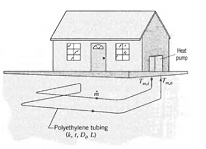Discuss the below in detail:
Q: Ground source heat pumps operate by using a liquid rather than ambient air, as the heat source (or sink) for winter heating (or summer cooling). The liquid flows in a closed loop through plastic tubing that is buried at a depth for which annual variations in the temperature of the soil are much less than those of the ambient air. For example, at a location such as South Bend, Indiana, deep-ground temperatures may remain at approximately 11 DC, while annual excursions in the ambient air temperature may range from -25°C to +37°C.
Consider winter conditions for which the liquid is discharged from the heat pump into high-density polyethylene tubing of thickness t = 8 nun and thermal conductivity k = 0.47 W/m · K. The tubing is routed through soil that maintains a uniform temperature of approximately 10°C at the tube outer surface. The properties of the fluid may be approximated as those of water.
(a) For a tube inner diameter and flow rate of Di = 25 mm and m = 0.03 kg/s and a fluid inlet temperature of Tm,i = 0°C, determine the tube outlet temperature (heat pump inlet temperature), Tm.o, as a function of the tube length L for 10 < l="">< 50="">
(b) Recommend an appropriate length for the system. How would your recommendation be affected by variations in the liquid flow rate?
